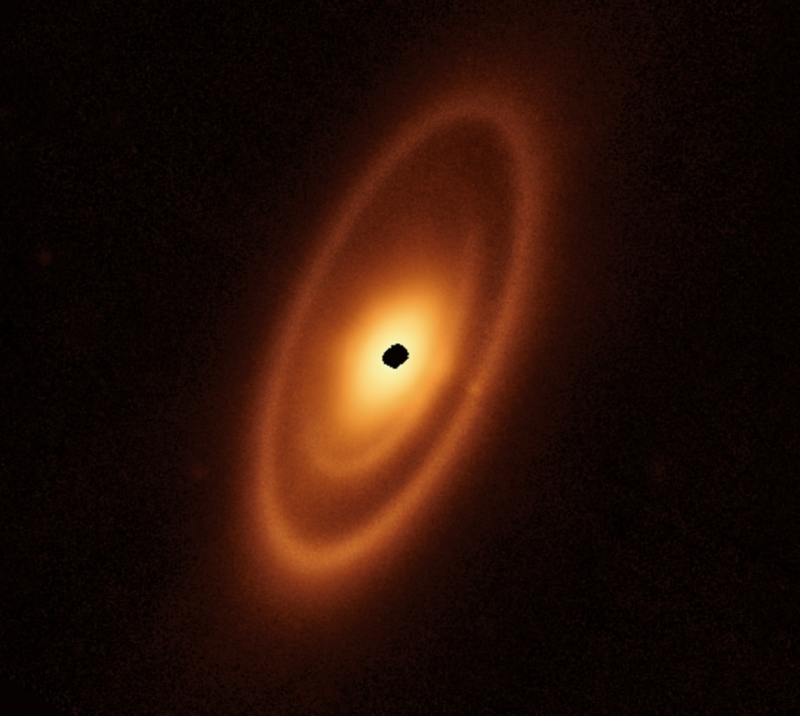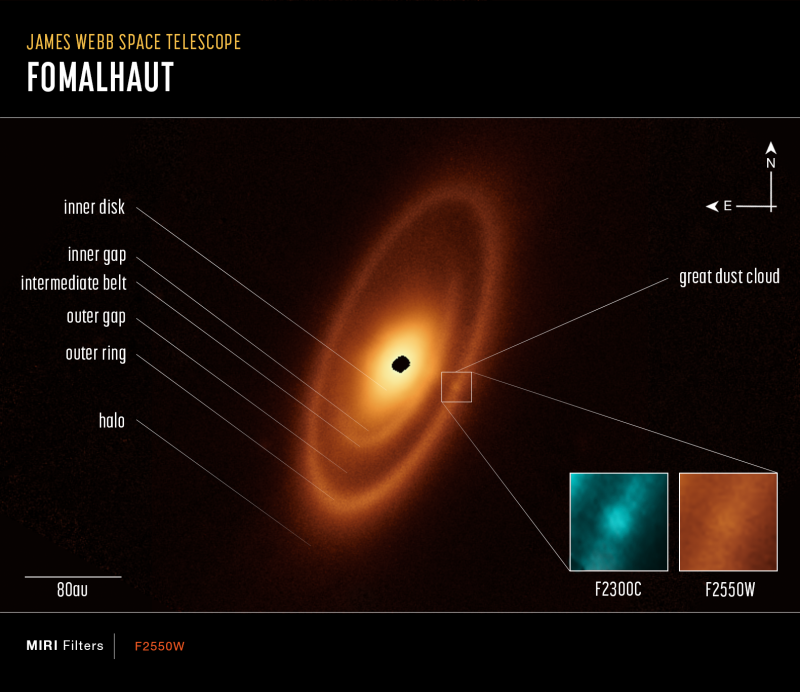
3 nested belts around Fomalhaut
The star Fomalhaut is a stand-out. Appearing from northerly latitudes as a solitary star in our autumn skies, it’s sometimes called the Autumn Star or the Loneliest Star. It’s the 18th brightest star in the sky. In 2003, the NASA Spitzer Space Telescope obtained the first infrared images of a dust disk surrounding Fomalhaut.** Planets are believed to form from such disks. On May 8, 2023, NASA said that scientists using the Webb Space Telescope have – for the first time – captured a total of three nested belts around the bright, solitary star Fomalhaut. These dusty debris disks form diffuse rings around the star out to a distance of 14 billion miles (23 billion km). The belts are like our own solar system’s asteroid belt and Kuiper belt, home to comets and larger bodies such as the dwarf planet Pluto.
They found the belts using Webb’s Mid-Infrared Instrument, aka MIRI.
The outermost ring around Fomalhaut – a bright star in the constellation Piscis Austrinus – was previously spotted by NASA’s Infrared Astronomical Satellite (IRAS) in 1983. But Webb’s infrared vision showed the inner rings for the first time. Team member Schuyler Wolff of the University of Arizona said:
Where Webb really excels is that we’re able to physically resolve the thermal glow from dust in those inner regions. So you can see inner belts that we could never see before.
The team published their results in the peer-reviewed journal Nature Astronomy on May 8, 2023.
Hidden planets among the disks
The dusty debris rings result from collisions of bodies around the star. This is much the same way that our own asteroid and Kuiper belts formed. Team leader András Gáspár of the University of Arizona said:
I would describe Fomalhaut as the archetype of debris disks found elsewhere in our galaxy, because it has components similar to those we have in our own planetary system. By looking at the patterns in these rings, we can actually start to make a little sketch of what a planetary system ought to look like, if we could actually take a deep enough picture to see the suspected planets.
It seems strange that we can see an asteroid belt around a distant star but not a larger planet. However, the thick, accumulated dust of these belts is still forming and glowing in the infrared. Any coalesced planet is what’s defining the rings and creating the gaps. This is similar to how Jupiter defines our asteroid belt and Neptune defines the Kuiper belt. Team member George Rieke of the University of Arizona said:
The belts around Fomalhaut are kind of a mystery novel: Where are the planets? I think it’s not a very big leap to say there’s probably a really interesting planetary system around the star.
Wolff added:
We definitely didn’t expect the more complex structure with the second intermediate belt and then the broader asteroid belt. That structure is very exciting because any time an astronomer sees a gap and rings in a disc, they say: “There could be an embedded planet shaping the rings!”
A disappearing planet
In 2008, the Hubble Space Telescope observed what looked to be a planet forming around Fomalhaut. But by 2014, the planet seemed to have disappeared. Astronomers think what they actually witnessed back in 2008 was:
… an expanding cloud of very fine dust particles from two icy bodies that smashed into each other.
In the new Webb image, we can see a great dust cloud as a lump in the outer ring. Astronomers think this dust cloud may be the evidence of an earlier collision.

Debris disks around other stars
The team is also expanding their search of debris disks to other stars. Earlier instruments, such as the Atacama Large Millimeter/ submillimeter Array (ALMA), were also able to image debris disks farther from their stars. As Wolff said:
With Hubble and ALMA, we were able to image a bunch of Kuiper Belt analogs, and we’ve learned loads about how outer disks form and evolve. But we need Webb to allow us to image a dozen or so asteroid belts elsewhere. We can learn just as much about the inner warm regions of these disks as Hubble and ALMA taught us about the colder outer regions.
Bottom line: Webb has spotted dusty debris disks around the star Fomalhaut. These 3 nested belts are similar to our solar system’s asteroid and Kuiper belts.
**Correction: An earlier version of this article stated that, in 2008, the Hubble Space Telescope captured the first-ever image of an exoplanet, later named Fomalhaut b. But that information was not entirely correct. It’s true that a study published in 2008 generated a lot of excitement when Hubble Space Telescope images, taken in 2004, 2006 and 2008 showed an apparent planet very close to a known debris ring for Fomalhaut. Astronomers first thought it was the first directly imaged exoplanet. But data from other telescopes brought that conclusion under scrutiny. And, by 2014, this object was no longer visible to Hubble.
Source: Spatially resolved imaging of the inner Fomalhaut disk using JWST/ MIRI











